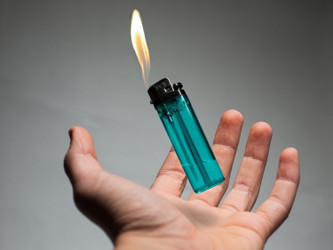The holy trinity of pipe smoking goes pipe, tobacco, lighter. If you’re interested in perusing a huge selection of tobacco pipes we suggest you make your way to the Paykoc Pipes online store. If you are in search of a tobacco that will dovetail with your aesthetic sensibilities we suggest you make your way to the nearest smoke shop. And if you want a lighter that won’t contaminate the natural flavor of the tobacco you purchase we suggest you pick up a high-quality butane lighter. Once you’ve purchased your lighter though you’ll need to make sure it’s always clean and functional. Read on to learn how to do that.
Why it’s Important to Clean and Maintain Your Lighter
Briar pipes and meerschaum pipes need to be cleaned, and if you want your lighter to always perform up to its potential you will need to get in the habit of conducting routine maintenance on it as well. You may wonder why that is. After all, a lighter is just a lighter. Right? Well, yes and no. You see, as butane burns, it produces a residue that can accumulate on the various components of the lighter and interfere with the lighter's operation.
Also, not all butane available on the market today is 100% pure. As a result, a lighter can seem empty when it actually isn't, or a flame can be weak and tenuous because what's left inside is mixed with air or not pure enough to burn consistently. The way to prevent these problems from happening is to clean and bleed the lighter on a regular basis.
How to Bleed a Lighter
Lighters that are low on fuel often sputter, flicker or produce an anemic flame. This is an indication that the fuel is low and that air is mixed in with the fuel. That happens after refilling the lighter multiple times. The way to fix that is to bleed out the air. Here’s how to bleed a butane lighter.
- Dial the flame down to its lowest setting. This should be considered non-negotiable because it can help prevent you from potentially getting seriously burnt.
- Take a hard object like a screwdriver or knife tip and press down on the fuel valve located at the bottom of the lighter. When you do you’ll hear a hissing sound. That’s the sound of trapped air being released along with any residual fuel. Do not inhale this mixture.
- Keep depressing the fuel valve until the hissing stops. At that point, you will have purged the lighter of unwanted air and old fuel.
- Get a can of pressurized air and use it to clean the lighter’s combustion chamber. It’s here that residual from the burning process, as well as dirt and other contaminants, typically accumulate.
- Using a clean soft cloth wipe down the whole lighter to remove any dirt or other contaminants that may have accumulated on the exterior. Now your lighter is ready to be refueled.
Here are some important things to keep in mind before, during and after refilling the lighter.
- Don’t shake the container of butane before filling the lighter with it. This will only increase the chances of air being introduced into the lighter when you refill it. And that is exactly what you are trying to avoid.
- Make sure to hold your lighter upside down while you fill it. At the same time make sure to hold the can of butane straight up and down and to apply even pressure against the refill valve. It only takes about ten seconds to refill the typical lighter so you won’t have to be holding this somewhat awkward position very long.
- When the lighter nears full it will begin to leak small amounts of butane from around the edge of the refill valve. When that happens it’s time to stop. No buts.
- After you have refilled the lighter and stored the butane can away properly take a fresh, dry cloth and wipe down the outside of the lighter thoroughly. Leaving residue from the filling process on the outside of the lighter runs the risk it will ignite next time you spark the lighter up.
- Now adjust the lighter to your preferred setting and let it sit for a few minutes before firing it up. Why? Because butane fuel is cold by nature and when you fill your lighter with it the entire lighter cools down. Allowing the lighter to absorb ambient heat and return to room temperature will help it perform better once you do fire it up.
Here are a few bonus tips for maintaining your lighter:
- Always use high-quality butane designated as 99.9% pure on the label. Also, keep an eye out for the phrase "triple-filtered" as this indicates high-quality fuel as well.
- Bleed and clean your lighter on a regular basis. Mark it on the calendar if you have to. Whatever it takes to establish good lighter maintenance habits.
- Don’t ever bleed your lighter near an open flame. Remember, we mentioned above that the hissing sound you hear when bleeding a lighter in not just air, it’s residual fuel as well. If you’re near a candle or other open flame while bleeding the lighter you run the risk of a fire.
Conclusion
Whether you’re a fan of briar pipes or meerschaum pipes you’ll have a more satisfying experience if you purchase a high-quality lighter and keep it clean. And for a world-class selection of wholesale tobacco pipes get in touch with the team at Paykoc Pipes.

 US Dollars
US Dollars
